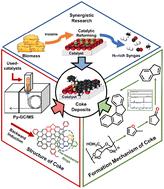Fe-Ni催化剂上“软”焦沉积中的五元环结构:形成机制及其对生物质催化重整的意义
IF 9.2
1区 化学
Q1 CHEMISTRY, MULTIDISCIPLINARY
引用次数: 0
摘要
在生物质热解挥发物重整过程中,催化剂上的焦炭沉积通常是催化剂失活的主要原因,也是催化剂设计的主要挑战。与简单的石墨碳层不同,焦炭沉积物由复杂的大分子化合物组成,这使得在分子水平上阐明其结构特征和形成机制变得困难。本研究基于固定床反应器对麦秸进行热解,然后在Fe-Ni催化剂上催化重整挥发物生成富h2合成气的过程,采用热解-气相色谱/质谱(ys - gc /MS)技术对焦炭沉积物热解产生的碎片分子进行了分析。用逆向归纳法首次揭示了含五元环焦炭的化学结构。快速热解实验证明了一次挥发物与催化剂之间的相互作用,固定床放大实验结合多相产物分析证明了催化剂在焦炭沉积中的作用。结果表明,催化剂载体引导挥发物的吸附和碳质物质的沉积,而金属位点促进环化和聚合反应。不同化学结构的焦炭沉积物对催化剂失活的影响不同。与以石墨碳为主的“硬”焦沉积相比,以五元环结构为特征的“软”焦沉积不是催化剂失活的主要原因,可以继续转化焦油。模型化合物研究指出,环戊酮是一种纤维素/半纤维素热解衍生物,是焦炭沉积物中五元环结构组装的关键中间体。通过实验与理论计算相结合,进一步阐明了焦炭的反应途径和形成机理。本研究为催化剂上焦炭沉积的结构分析和形成机理提供了一些见解。本文章由计算机程序翻译,如有差异,请以英文原文为准。

Unveiling the five-membered ring structures in “soft” coke deposits on Fe–Ni catalysts: formation mechanisms and implications for biomass catalytic reforming
Coke deposits on catalysts during the reforming of biomass pyrolysis volatiles are usually the primary cause of catalyst deactivation and a major challenge for catalyst design. Unlike simple graphite carbon layers, coke deposits consist of complex macromolecular compounds, making it difficult to elucidate their structural features and formation mechanisms at the molecular level. In this work, based on the pyrolysis of wheat straw in a fixed-bed reactor followed by catalytic reforming of volatiles over Fe–Ni catalysts to produce H2-rich syngas, pyrolysis-gas chromatography/mass spectrometry (Py-GC/MS) was employed to analyze fragmented molecules derived from the pyrolysis of coke deposits. The chemical structure of coke deposits containing five-membered rings was demonstrated for the first time by backward induction. Fast pyrolysis experiments demonstrated the interactions between primary volatiles and the catalyst, while fixed-bed scaled-up experiments combined with multiphase product analysis demonstrated the role of the catalyst in the formation of the coke deposits. The results showed that the catalyst support guided the adsorption of volatiles and the deposition of carbonaceous species, while metal sites promoted cyclization and polymerization reactions. Coke deposits with different chemical structures contribute differently to catalyst deactivation. Compared to “hard” coke deposits dominated by graphitic carbon, “soft” coke deposits characterized by five-membered ring structures were not the main cause of catalyst deactivation and could continue to convert tar. Model compound studies pinpointed cyclopentenone, a cellulose/hemicellulose pyrolysis derivative, as a key intermediate for the assembly of five-membered ring structures in coke deposits. The reaction pathways and mechanisms of coke formation were further elucidated by combining experimental and theoretical calculations. This study provides some insights for the structural analysis and formation mechanisms of coke deposits on catalysts.
求助全文
通过发布文献求助,成功后即可免费获取论文全文。
去求助
来源期刊

Green Chemistry
化学-化学综合
CiteScore
16.10
自引率
7.10%
发文量
677
审稿时长
1.4 months
期刊介绍:
Green Chemistry is a journal that provides a unique forum for the publication of innovative research on the development of alternative green and sustainable technologies. The scope of Green Chemistry is based on the definition proposed by Anastas and Warner (Green Chemistry: Theory and Practice, P T Anastas and J C Warner, Oxford University Press, Oxford, 1998), which defines green chemistry as the utilisation of a set of principles that reduces or eliminates the use or generation of hazardous substances in the design, manufacture and application of chemical products. Green Chemistry aims to reduce the environmental impact of the chemical enterprise by developing a technology base that is inherently non-toxic to living things and the environment. The journal welcomes submissions on all aspects of research relating to this endeavor and publishes original and significant cutting-edge research that is likely to be of wide general appeal. For a work to be published, it must present a significant advance in green chemistry, including a comparison with existing methods and a demonstration of advantages over those methods.
 求助内容:
求助内容: 应助结果提醒方式:
应助结果提醒方式:


